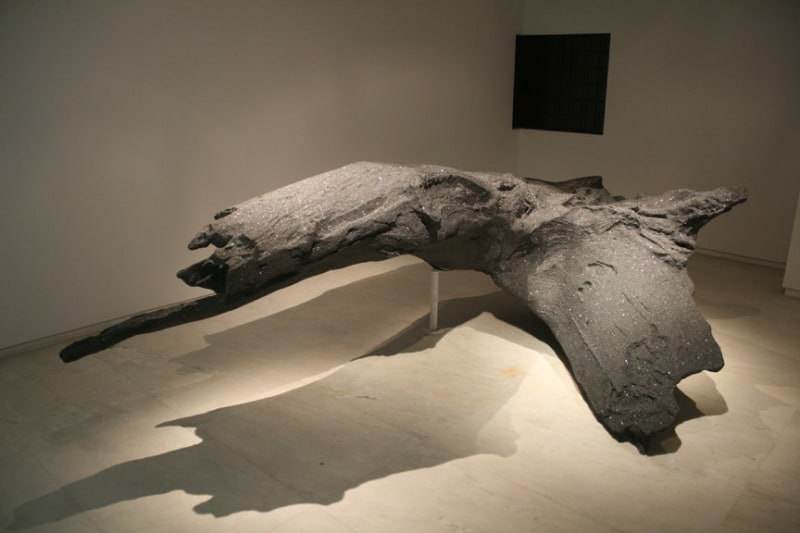
Unfixed Being: Sculpture by A. Balasubramaniam (Van Every/Smith Galleries, Davidson College, October 14-December 7, 2005) features six recent and surreal works by the Indian artist known as Bala. Convincing, his trompe l'oeil sculptures posit illusion as the means for viewers to access the works. Bala relies on our habits of perception, which he harnesses subtly, Bala understands that art is first absorbed through one's senses. He is not, however, merely a trickster. Bala is an alchemist who uses objects and scenarios from the physical world to create sculptures inspired by psychology and spirituality. All of this wrapped in a humanist perspective reminiscent of German artist Joseph Beuys, whom Bala cites as one of his major influences.
Most of the works in Unfixed Being: Sculpture by A. Balasubramaniam are white-on-white installations from the last three years. In them, Bala makes full use of the space, and of our passage through it. In the first gallery, Untitled features a sinewy arm holding a rope and pulling tirelessly at the opposite wall. The arm's musculature and the wall's puckered surface evoke effort and resistance - a Sisyphus-like, existential scenario. Man and his environment are at a standstill, in a deadlock of equal strength and resolve.
Bala's best-known work is also in the first gallery. Self in Progress, 2002, is a fiberglass cast of the artist's body. Shirtless, he slouches. His bare back and neck softly arc into the gallery's partition. Whereas Untitled's arm was born of the wall, this character's head dies in it. Around the corner, the man's knees, calves, and feet protrude. His face does not. Burying his head in the wall, Bala alludes to psychological symptoms - such as denial and isolation- that limit personal growth. The protruding legs, however, maintain hope that he may eventually surface.
Emerging Angels, 2004, hangs from the ceiling in two breadbox-sized vitrines in the second gallery. Cloudy, biomorphic spheres surround tiny angel statuettes. A chemical reaction between the objects and an evaporating compound forms these orbs. The artist becomes an alchemist, using scientific processes to create objects and as a metaphor for the inevitability of change, of transmutation.
Weights hang from ropes, tugging on the wall's surface in another work installed in this room. Less polysemantic than the previous works, this untitled installation from 2004 reflects Bala's interest in natural laws such as gravity. Tree Inside, 2005, is the last sculpture in the second gallery. A gilded fiberglass tree trunk hangs from the ceiling next to a backlit digital print. The location and scale of the image fail to fully consider the space. Bala's intention is also less clear in this sculpture, adding to its distracting nature.
In, But out, 2005, the exhibition's most successful work, occupies the third gallery. A fissured mold of Bala's body is divided into a front and a back. The two half-figures stand at attention. They are mounted into opposite walls of the airy, square room. Here, Bala's ability to fool the eye works on several levels. From a distance, the recessed figures seem three-dimensional. They appear to protrude from the wall. Traversing the room, figures rotate in synch with one's steps. This split figure furthers Bala's psychological exploration by referencing the often-complicated nature of the self. It is also the strongest example of Bala's ability to manipulate perception. The effect is so realistic that even after we understand what we are really seeing, the illusion remains intact. In Bala's In But Out, intellect actually surrenders to perception. In the end, the alchemist's illusion trumps reality.
-Terri Smith